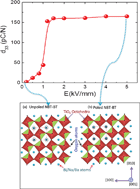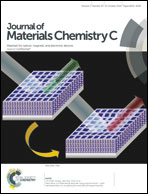Effect of poling on nanodomains and nanoscale structure in A-site disordered lead-free piezoelectric Na0.5Bi0.5TiO3–BaTiO3†
Abstract
This paper establishes the nanoscale poling mechanism operating in A-site disordered lead-free piezoelectric ceramics. Nanoscale domain maps and quantitative structural changes were obtained by deploying high-resolution transmission electron microscopy, dielectric spectroscopy, Raman spectroscopy and neutron scattering. Based on these results a microscopic model is proposed that provides insight into the E-field induced structural transformation. The stripe-like nanodomains in the unpoled system transformed into lamellar tetragonal domains with a reduced degree of displacement disorder during poling. It is proposed that the synergic effect of change in octahedral tilt disorder and cation displacement disorder leads to this transformation under an E-field. The criterion for achieving superior functional response includes stabilization of the long range order and reduction in the tilt disorder through compositional adjustments. Understanding of the poling mechanism in lead-free piezoelectric materials has been mostly limited to the behavior of domains under an applied field. However, this work provides an in-depth understanding of the changes in the local structure along with domain morphology under an applied field.


 Please wait while we load your content...
Please wait while we load your content...